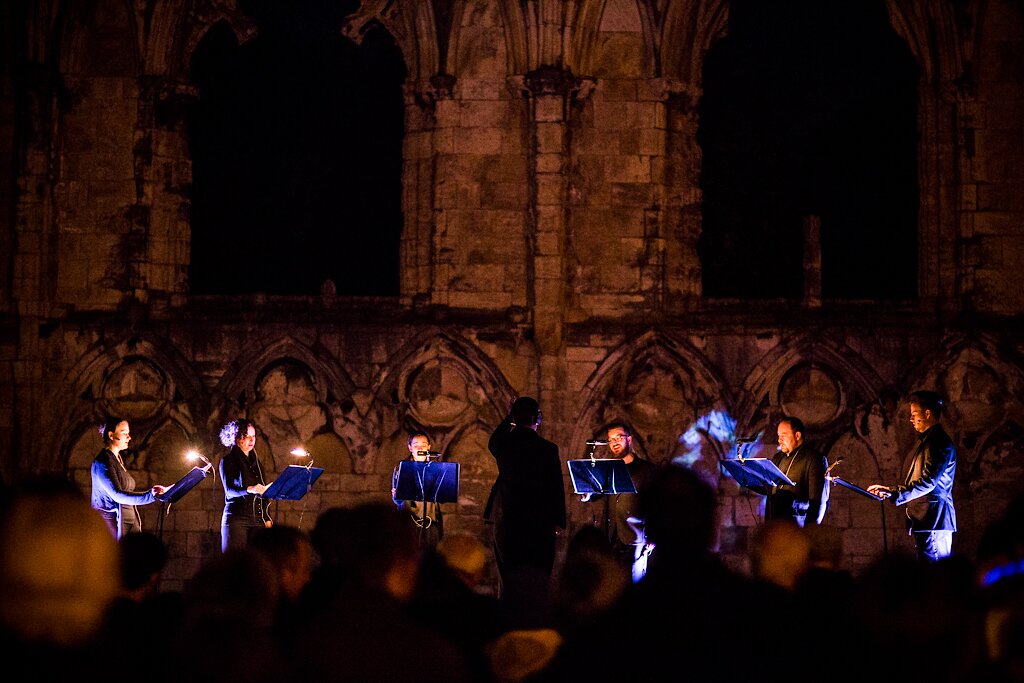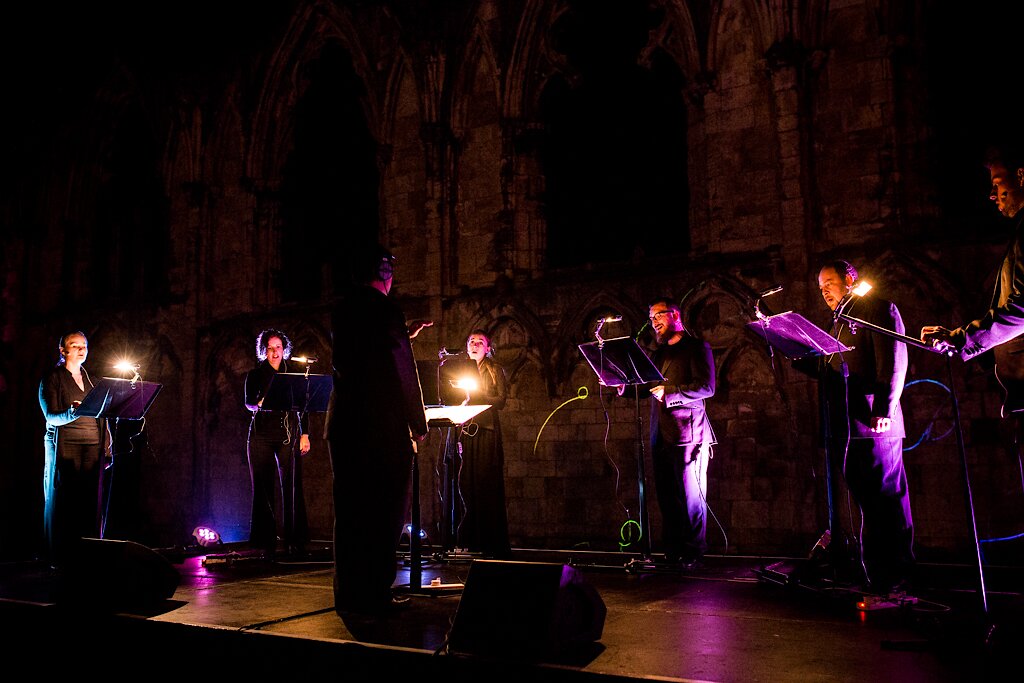The Architexture Series Music
The Architexture Series of works makes use of the sonic profile of buildings as an evidence base for musical composition.
Detailed links between the musical score and the unique spatial and acoustic characteristics of the performance site are embedded within these compositions. Modelling the acoustic in this way during the musical composition process can help achieve a closer bond between the notes on the page and the sound perceived by listeners. The purpose of this project is to blur the lines between space, live-art and performance by allowing the situated built environment to become an essential part of a living and evolving musical construction process.
Traditionally, composers for centuries have anticipated how spaces are appropriate for the music they write, and acoustic music generally reflects the constraints of performance acoustics it was intended for. In the Architexture Series the resonant sounds created by buildings in response to the perfromance are not left to chance. Instead, the whole system of performers, space, and the musical score is treated as a sound-making environment which can be designed for. This work builds on traditional ideas of writing music for a particular space and re-thinks some of the inherent relationships involved. It attempts to use the space itself as a live sonic performer within an ensemble - an active contributor to an unfolding composition - rather than as a static ‘effect’. Through designing structured ways to provoke reverberation, to blur certain harmonies and not others, to respond to particular spatial locations and not others, opens up new compositional possibilities. This is only possible through detailed acoustical analysis and a composition process which makes use of this information as an evidence-base for sculpting lines and harmonies.
The Architexture Series presently comprises three explorations into this area through addressing the layering of past and present within a heritage building (The Guildhall, York), a large-scale openair public Augmented Reality Presentation (European researcher’s night), and a spatially recorded piece of audio under controlled studio conditions.New relationships between the audience, the performance site and performers emerge from these bespoke pieces of music for voices. Architexture I and Architexture 2 both draw on a combination of Renaissance influenced musical craft and spatial data provided through contemporary digital techniques.

Sites, resonances, and history
Reverberation has always been attractive to me as a composer: the joy of hearing performances where buildings make a unique contribution to the event is a thrilling experience. However, I started to wonder about how composers might further design the effects the building was producing alongside designing the musical score itself. Setting aside famous examples such as Gabrielli, many composers tend to think about the acoustic in every aspect of the music they make, looking for clarity of presentation or whether certain textures will simply ‘work’ in a space. The environment has an imprint on the types and styles of music what we create. I wanted to take this idea a little further, and explore how the sounds of the performance site could be generated and manipulated by the ensemble: building an ensemble as a unified system, extending and challenging the concept of performance ‘for’ a space. Alvin Lucier’s piece, I am sitting in a room plays back a room’s particular resonance into itself, converting the resonance to a sound source in its own right. There are no other sound sources in Lucier’s piece, nor are there any performers. I wanted to harness this now familiar relationship (the idea of ‘room tone’, as filmmakers would put it) and take it to a new level: what happens when that resonance itself is manipulated by the performance. To do this required knowing about the detailed acoustic response of venues in advance of composing, and the construction of a computer modelling system so that the notated results of the musical composition could be visualised as harmony with a detailed reverberation profile of the building factored in. My method for doing this is discussed in a research chapter in this publication. With these tools, when it came to putting notes on the page I could understand the effects and contribution the building would make to the totality of the sounding experience the audience would be immersed within.
Composition, Live-Art and Augmented Reality (AR).
It would be relatively straightforward to map reverberant data points as a kind of sonification. (Sonification doesn’t rule out musicality - it is just a different type of process). Instead, data here in the Architexture Series informs a process where the music I write for performers is shaped and moulded appropriately, treating the reverberation as a line or part in its own right in what is already a dynamic, complex system of interactions. This creates a piece of live-art: the existing building having it’s role changed and adapted by the music.
In Architexture II, we worked with a building that doesn’t presently exist today through reconstruction and modelling of that space, brought alive by music which specifically uses those spatial characteristics, presented as an audio Augmented Reality. See the Architexture II page for details.
Multi-disciplinary collaboration
Architexture is a multi-disciplinary project which would not be possible without arts-science collaboration, made possible at the University of York, UK. Often, Art is used as a demonstrator or engagement tool for science. In this case however, acoustic engineering (here in the form of the capture of impulse responses) is a key enabler in creating new forms of immersive public experience through musical craft. Through new music designed to explore site in new ways (rather than through the performance of existing work), creating a situation where the audience are less observers and more participants. The overlay of space and place allows us to think critically about the sites, buildings and the communities which make (or have made) use of them.
Meet the team
Ambrose Field and Jude Brereton, project leads
Jude Brereton, Helena Daffern | acoustic engineering research
Paul Gameson | Conductor, Ebor Singers
The Ebor Singers | Ensemble
Ambrose Field | Musical composition, acoustic mapping
The Architexture II performance was made possible through the work of:
Steven Oxnard | St Mary’s Impulse Response Model and Calculation
Ameila Gully | Acoustics
Lewis Thresh | Processing Graphics
Thmoas Krauss | Light
Ian Martindale | Photography
Radek Rudnicki | Event Video
Damian Murphy | Acoustics Engineering
Andrew Chadwick | Ambisonics and Live Sound
Ben Pugh | Event Management
Publications about project
Book chapters:
Field A. (2016) Composing for the Resonance. Open Music Composer’s Book Vol. 3. Jean Bresson, Gérard Assayag, and Carlos Agon, eds. Paris: Editions Delatour, IRCAM.
Brereton, J. (2017) Music perception and performance in virtual acoustic spaces. Body, Sound and Space in Music and Beyond: Multimodal Explorations. Wöllner, C. (ed.). Routledge.
Related Articles:
Murphy, D. T., Shelley, S. B., Foteinou, A., Brereton, J. S. & Daffern, H. (2017), Acoustic Heritage and Audio Creativity: the Creative Application of Sound in the Representation, Understanding and Experience of Past Environments. Special issue in Internet Archaeology.
Presentations:
Field, A. (2016) Sound in space - Research colloquia, HKBU, HongKong, Sept 2016.
Field, A.: (2017) Reverse Spectralism: designing for the acoustic, University of Oxford, Spectralisms Conference, March 16⁄17, 2017.
Field, A., Brereton J.,(2015): Architexture II Realisation, European Researchers’ night, York, Sept 25th, 2015
Initial work was presented by Field and Brereton at Sounds in Space Symposium, University of Derby, 2014.
Bringing contemporary perspectives to historical architecture
The architexture project has involved creating bespoke music for sites of historic, cultural and acoustic interest. In the heritage context, we have rejected ideas of providing a kind of ‘audio time travel’ (or taking the audience back to a particular period in time) in favour of creating a situation where the public can experience the past and present together in a unified way through immersive music - inviting thoughtful engagement through personal comparison between past and present.
Listen
Further explore the Architexture Series here:
Architexture I
Architexture II
Architexture III is presently in production.
related work:
Pod Twoja Obrne
for 25 part choir.
Commissioning for your venue
The architexture team produce exciting new musical work which engages with ensembles, heritage and communities. If you would like to explore working with us we’d be happy to hear from you.

